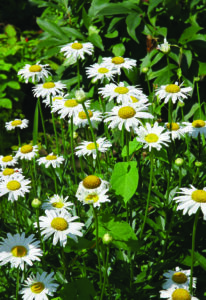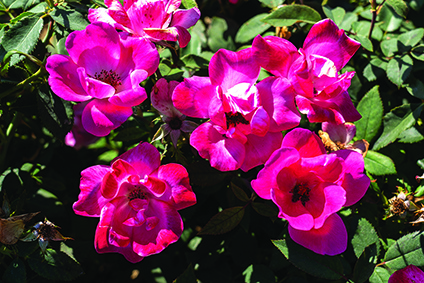
Classic and steady, shasta daisies fall into the no-fuss repeat bloom category.
In the movie, “Dennis the Menace,” Walter Matthaus Mr. Wilson gathers his garden club for an elaborate celebration of his corpse flower bloom, an occurrence that would only happen every 40 years.
All the work he put into the event ended up being missed due to a tortuous Dennis mishap.
While that is an extreme scenario, it does seem that you work and look forward to seeing your flowers bloom for months only to discover you’re on vacation for their prime week.
While most flowers have traditionally been “one-and-done,” there are some varieties curated to bloom multiple times.
Of these “rebloomers,” many are flowers that have traditionally grown once a year when your grandparents were growing up and are now a hybrid, bred to make multiple appearances.
If you have a certain flower you’d like, research or ask at your local garden shop if there are any that will make a second or possible third appearance.
While the most common Iris variety on the Shore seems to be shades of purple that come to an end of blooming season right around Memorial Day, don’t write all Iris off for longer bloom periods.
Some of those traditional purple beauties have probably been making their once yearly appearance from being planted decades ago!
These days there are several varieties that now rebloom- so many in fact, that there is a “Reblooming Iris Society” which subcategories them into “Rebloomers” with two or more flushes of bloom each year; “Cycle rebloomers” blooming in the spring and fall; “Repeaters” that bloom back to back in the spring and “All-season rebloomers” that produce on and off during the season.
They come in many colors, from delicate blues to vibrant yellows and soft peaches, you’ll certainly want to see them pop up more than once.
Daylilies are another contender for lovely bulbs that can pop up over and over.
“The Happily Ever Appster” series, all bred from Dr. Darrel Apps, includes many varieties with names that would rival any nail polish line, such as “When My Sweetheart Returns,” “Romantic Returns,” “Passionate Returns.”
Not only do they bloom more times, but the flowers last longer than older varieties as well.
With these overachieving irises and daylilies and other bulb rebloomers, as they are regrowing and repopulating so often, you’ll have to watch them a bit closer than you would your typical varieties. Everything from watering to dividing them up may have to happen more frequently. More work, but more bloom power.
Not every “rebloomer” is a new cultivar, nor are they all showstoppers. Some are understated, yet pleasant additions to your garden and a great pollinator, too.
Classic and steady, coneflowers, Black Eyed Susans and shasta daisies all fall into the no-fuss repeat bloom category.
When it comes to flowering shrubs, there’s also been some improvements in keeping color around longer.
Boomerang Lilacs are an aromic showstopper that have garnered attention as a repeat bloomer.
While lilacs typically only bloom in the spring, this variety will “boomerang” back after resting in June with more flowers in the summer and even into fall before frost.
The second round of purple flowers are smaller and more delicate but still lovely.
Unlike other repeaters, Boomerang lilac bushes actually stay smaller than non-repeating varieties, bushing out at around 4-5 feet rather than 10 and are also less deterred by disease than earlier varieties.
Hydrangeas are another shrub that can be a repeat bloom, with the most popular series being the “Endless Summer” line.
Flowering happens on both old and new growth which even in Zone 7 will keep you in flowers until frost.
The flowers can be anything from a vibrant pink with “Summer Crush” to the classic blues of the “Bigleaf” varieties. Hydrangeas are a bit finicky and with the endless summer, you’ll want to make sure you offer “endless water” for heat waves.
The popular “Knock Out” Roses varieties are celebrating 20 years of “Roses for every day, every one and every where,” touting that “no other flowering shrub blooms as long or as often!”
This game changer line of roses not only has a variety of hues, but now offers petite, climbing and even “double” varieties that rival the petals of older, more lush varieties.
While past varieties of roses made their regal one-time appearance in June, Knockouts have a 5- to 6-week bloom cycle that can repeat up to seven times into the fall weather.
They aren’t the only roses to be considered floribundi, latin for “full of flowers,” but are the most well known line of roses.
They are also cultivated to be hardy and not be susceptible to disease which is a plus for any gardening endeavor.
If you are adding to your garden or redoing a spot, rebloomers may be a fit.
Breeders continue to develop the next shade, the next hardiness level and now, longer last blooms so you can have your old favorites but enjoy them more often.
While the claims do very much mimic a late night QVC commercial, they likely will bring you more joy and happiness.




